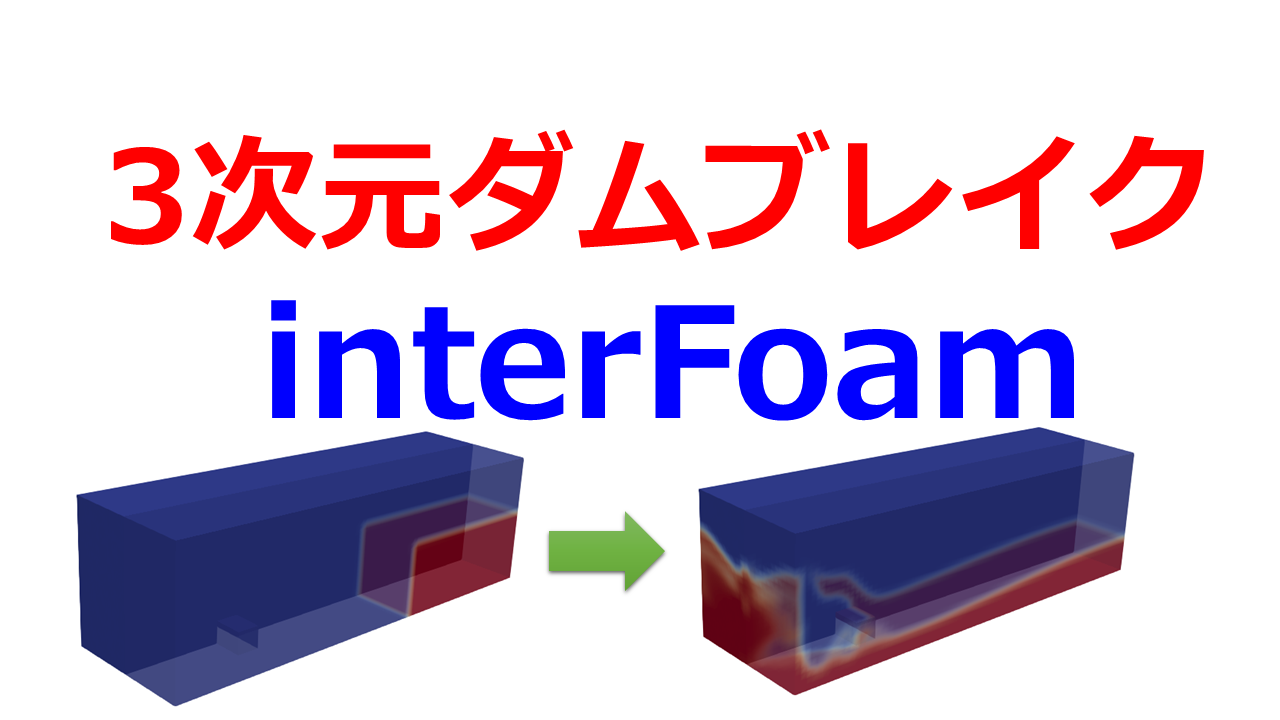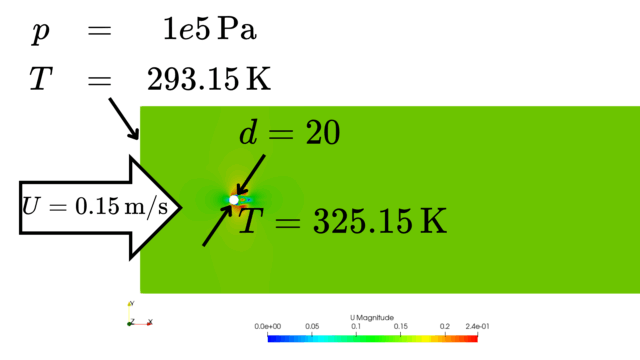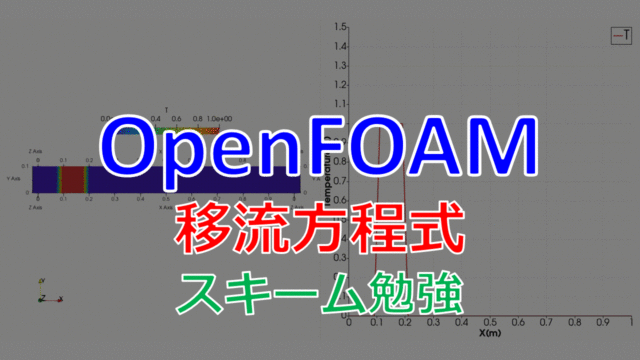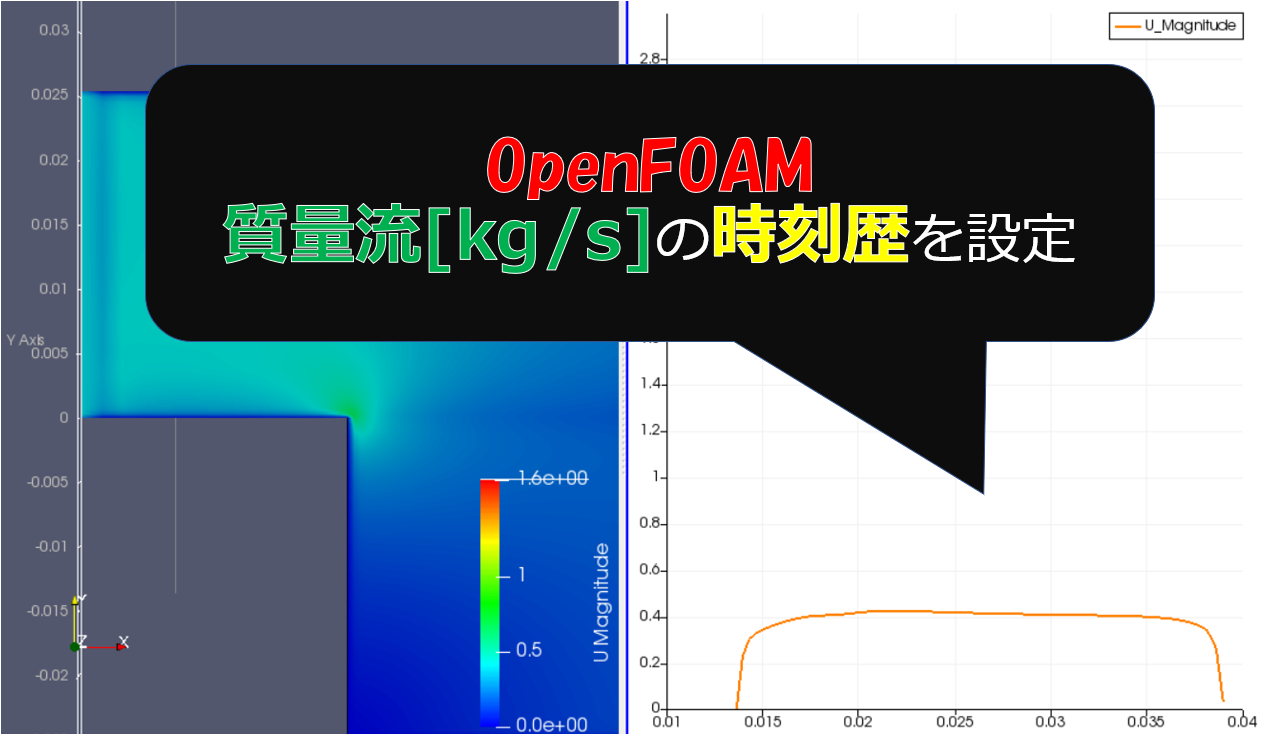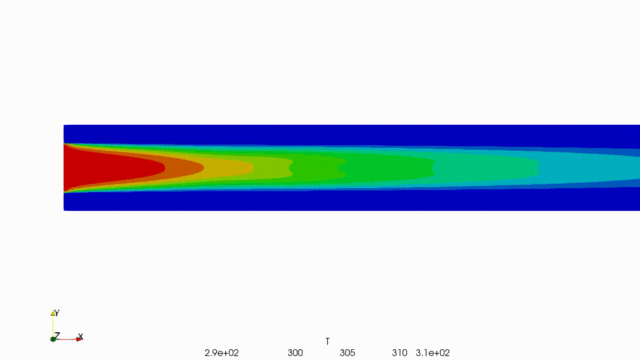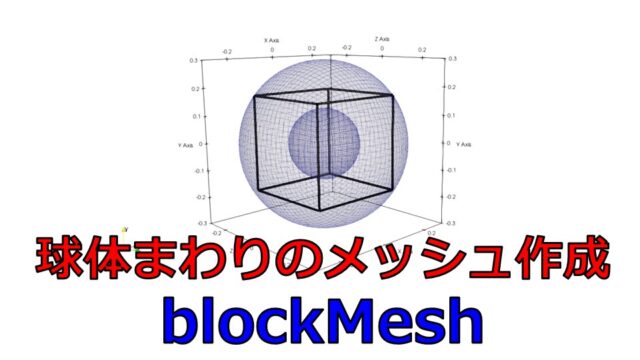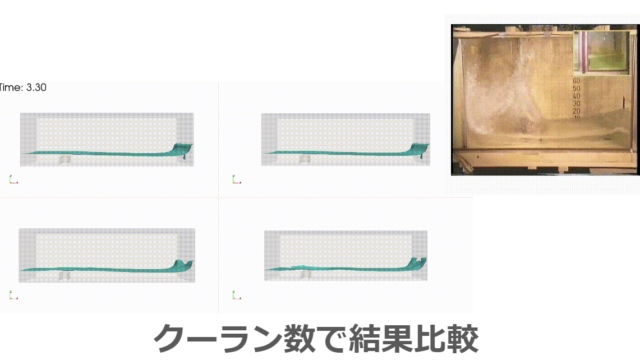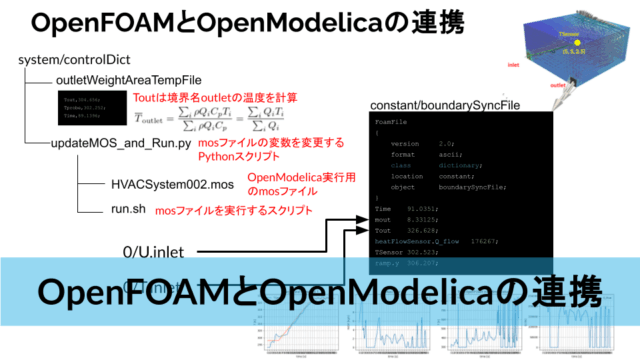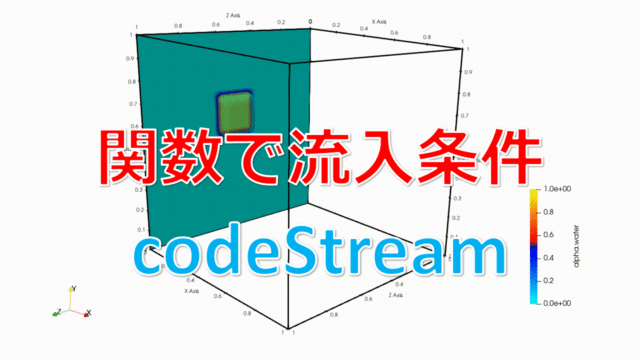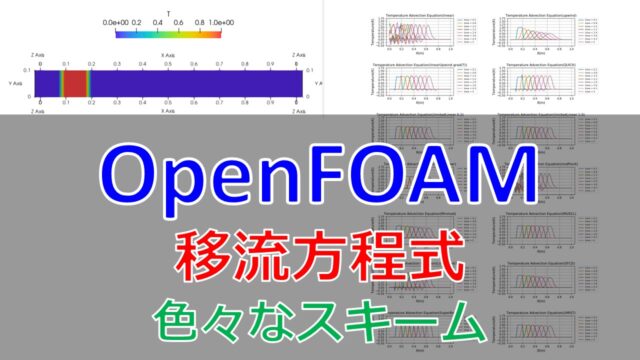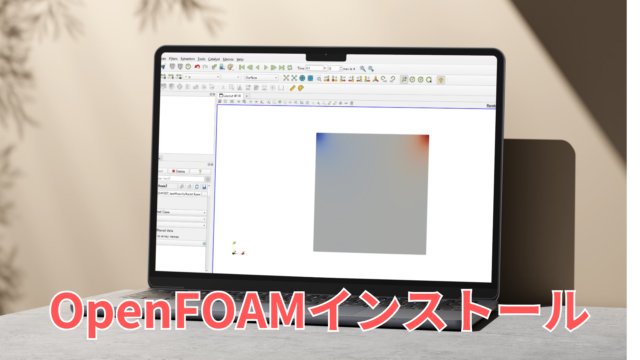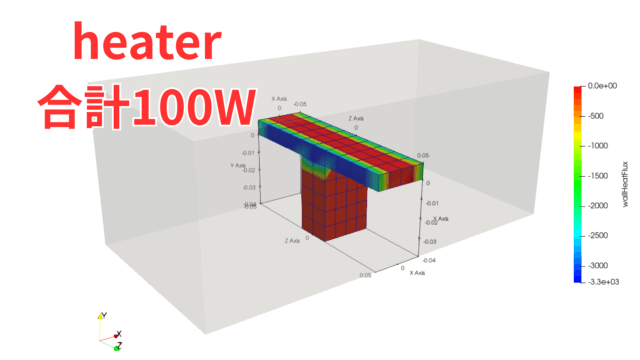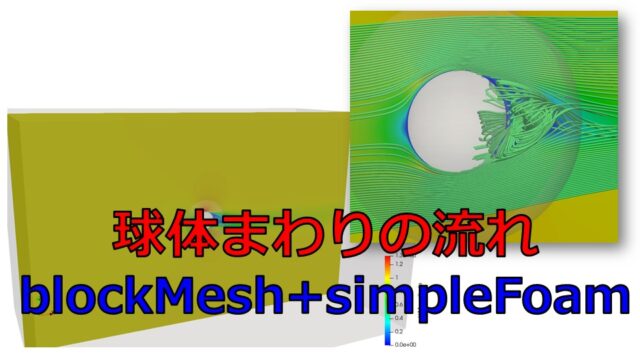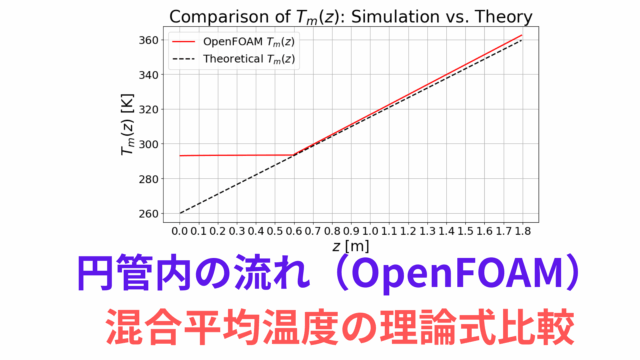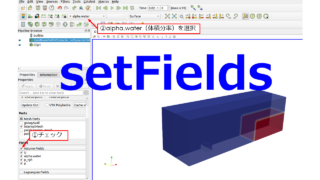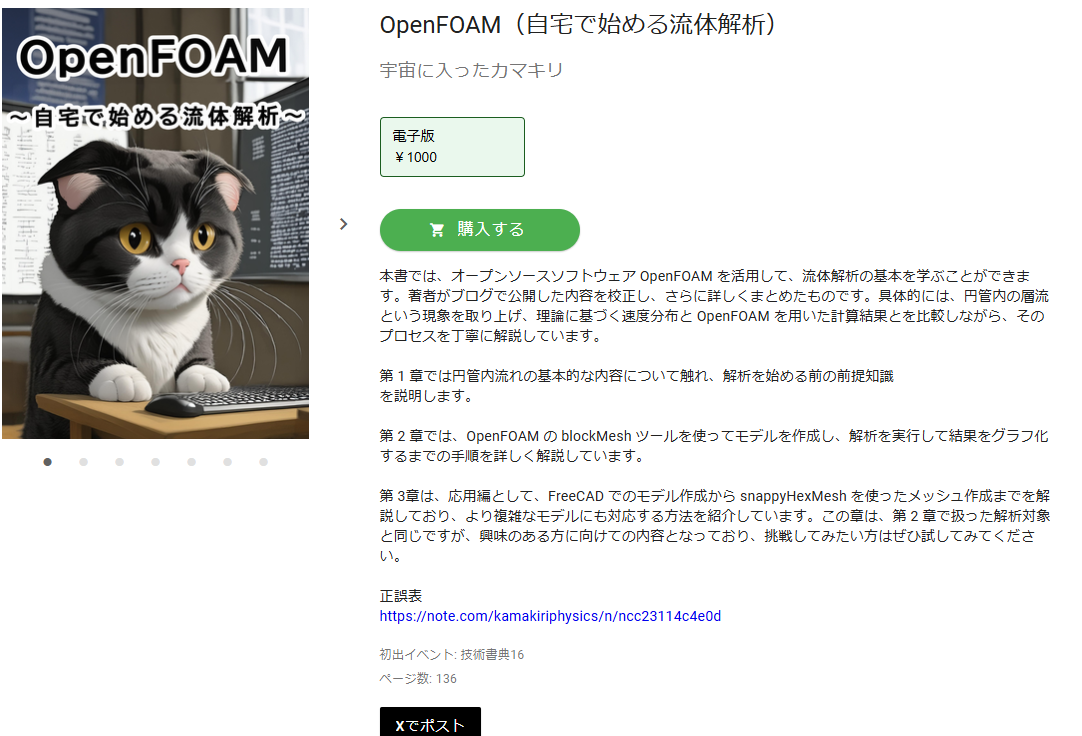こんにちは(@t_kun_kamakiri)
今回は3次元ダムブレイクの実験と同じ状況をOpenFOAMで再現しようと思います。
使用しているベースとなるチュートリアルは「$FOAM_TUTORIALS/multiphase/interFoam/laminar/damBreakWithObstacle/」よりコピーして使っています。
3次元ダムブレイクの流体解析をOpenFOAMで実施。
OpenFOAM初心者でチュートリアルを動かしたことがある方を対象にしています。
DEXCS2020
OpenFOAM v2006
解くべき方程式
OpenFOAMの2相流のソルバ”interFoam”を用いて3次元ダムブレイクの解析を行います。
ツール
- OpenFOAM:v2006
- ソルバ:inerFoam
解くべき方程式
- 運動方程式(2次元)
- 体積分率の保存
- 表面張力
※VOFによる界面の表現
今回使っている「interFoam」のソルバはVolume Of Fluid(VOF)法による、二相流ソルバーです。
相の区別を各相の体積分率(0~1)で行い、密度や粘性を体積分率をかけて、ナビエストークス方程式を解いています。
ナビエストークス方程式
密度
粘性
表面張力
非圧縮の条件
体積分率の移流方程式
※\(\alpha_{2}=1-\alpha_{2}\)
※\(\kappa\):界面の曲率
※\(\gamma\):界面張力
解析設定
今回は乱流モデル無しで行います。
|
1 2 3 4 5 6 7 8 9 10 11 12 13 14 15 16 17 18 19 20 21 |
/*--------------------------------*- C++ -*----------------------------------*\ | ========= | | | \\ / F ield | OpenFOAM: The Open Source CFD Toolbox | | \\ / O peration | Version: v2006 | | \\ / A nd | Website: www.openfoam.com | | \\/ M anipulation | | \*---------------------------------------------------------------------------*/ FoamFile { version 2.0; format ascii; class dictionary; location "constant"; object turbulenceProperties; } // * * * * * * * * * * * * * * * * * * * * * * * * * * * * * * * * * * * * * // simulationType laminar; // ************************************************************************* // |
今回こちら「$FOAM_TUTORIALS/multiphase/interFoam/laminar/damBreakWithObstacle/」のチュートリアルを利用していますが、乱流モデルなしのケースファイルでも「k,nut,omega」ファイルがありますが、こちらは乱流モデルの際に使うので今回は特に設定をしなくも良いです(使っていないので)。
|
1 2 3 4 5 6 7 8 9 10 11 12 13 14 15 16 17 18 19 20 21 22 23 24 25 26 27 28 29 30 31 32 33 34 35 36 37 |
/*--------------------------------*- C++ -*----------------------------------*\ | ========= | | | \\ / F ield | OpenFOAM: The Open Source CFD Toolbox | | \\ / O peration | Version: v2006 | | \\ / A nd | Website: www.openfoam.com | | \\/ M anipulation | | \*---------------------------------------------------------------------------*/ FoamFile { version 2.0; format ascii; class volVectorField; location "0"; object U; } // * * * * * * * * * * * * * * * * * * * * * * * * * * * * * * * * * * * * * // dimensions [0 1 -1 0 0 0 0]; internalField uniform (0 0 0); boundaryField { region_maxZ { type pressureInletOutletVelocity; value uniform (0 0 0); } ".*" { type noSlip; } } // ************************************************************************* // |
|
1 2 3 4 5 6 7 8 9 10 11 12 13 14 15 16 17 18 19 20 21 22 23 24 25 26 27 28 29 30 31 32 33 34 35 36 37 |
/*--------------------------------*- C++ -*----------------------------------*\ | ========= | | | \\ / F ield | OpenFOAM: The Open Source CFD Toolbox | | \\ / O peration | Version: v2006 | | \\ / A nd | Website: www.openfoam.com | | \\/ M anipulation | | \*---------------------------------------------------------------------------*/ FoamFile { version 2.0; format ascii; class volScalarField; object p_rgh; } // * * * * * * * * * * * * * * * * * * * * * * * * * * * * * * * * * * * * * // dimensions [1 -1 -2 0 0 0 0]; internalField uniform 0; boundaryField { ".*" { type fixedFluxPressure; phi phiAbs; value uniform 0; } region_maxZ { type totalPressure; p0 uniform 0; } } // ************************************************************************* // |
|
1 2 3 4 5 6 7 8 9 10 11 12 13 14 15 16 17 18 19 20 21 22 23 24 25 26 27 28 29 30 31 32 33 34 35 |
/*--------------------------------*- C++ -*----------------------------------*\ | ========= | | | \\ / F ield | OpenFOAM: The Open Source CFD Toolbox | | \\ / O peration | Version: v2006 | | \\ / A nd | Website: www.openfoam.com | | \\/ M anipulation | | \*---------------------------------------------------------------------------*/ FoamFile { version 2.0; format ascii; class volScalarField; location "0"; object alpha.water; } // * * * * * * * * * * * * * * * * * * * * * * * * * * * * * * * * * * * * * // dimensions [0 0 0 0 0 0 0]; internalField nonuniform List<scalar> boundaryField { region_maxZ { type inletOutlet; inletValue uniform 0; value uniform 0; } ".*" { type zeroGradient; } } |
チュートリアルは空気と水の界面でのメッシュを時刻歴で再分割するようにdynamicMeshが採用されています。
今回このような設定では解析時間がとてもかかるのと、結果処理がものすごく重いためノートPCで耐えられる計算ではないため、「dynamicFvMesh staticFvMesh;」を使って無効にしておきます。
|
1 2 3 4 5 6 7 8 9 10 11 12 13 14 15 16 17 18 19 20 |
/*--------------------------------*- C++ -*----------------------------------*\ | ========= | | | \\ / F ield | OpenFOAM: The Open Source CFD Toolbox | | \\ / O peration | Version: v2006 | | \\ / A nd | Website: www.openfoam.com | | \\/ M anipulation | | \*---------------------------------------------------------------------------*/ FoamFile { version 2.0; format ascii; class dictionary; location "constant"; object dynamicMeshDict; } // * * * * * * * * * * * * * * * * * * * * * * * * * * * * * * * * * * * * * // dynamicFvMesh staticFvMesh; // |
計算時間もかかるため4並列にして計算を実行します。
|
1 2 3 4 5 6 7 8 9 10 11 12 13 14 15 16 17 18 19 20 21 |
/*--------------------------------*- C++ -*----------------------------------*\ | ========= | | | \\ / F ield | OpenFOAM: The Open Source CFD Toolbox | | \\ / O peration | Version: v2006 | | \\ / A nd | Website: www.openfoam.com | | \\/ M anipulation | | \*---------------------------------------------------------------------------*/ FoamFile { version 2.0; format ascii; class dictionary; object decomposeParDict; } // * * * * * * * * * * * * * * * * * * * * * * * * * * * * * * * * * * * * * // numberOfSubdomains 4; method scotch; // ************************************************************************* // |
scotchを使えば適当に最適化して分割してくれます。
その他の設定は特に触っていないのでそのままでいきます。
設定が終わったので以下のコマンドで解析を実行しましょう。
|
1 2 3 |
decomposePar mpirun -np 4 interFoam -parallel reconstructPar |
計算が終わったらparaviewで結果を確認しましょう。

このように水が崩れて障害物で水しぶきを上げている結果が得られました。
まとめ
今回は3次元ダムブレイクの解析実行までを行いました。
次回は、3次元ダムブレイクの実験との比較を行います。
実験の様子はこちらです。
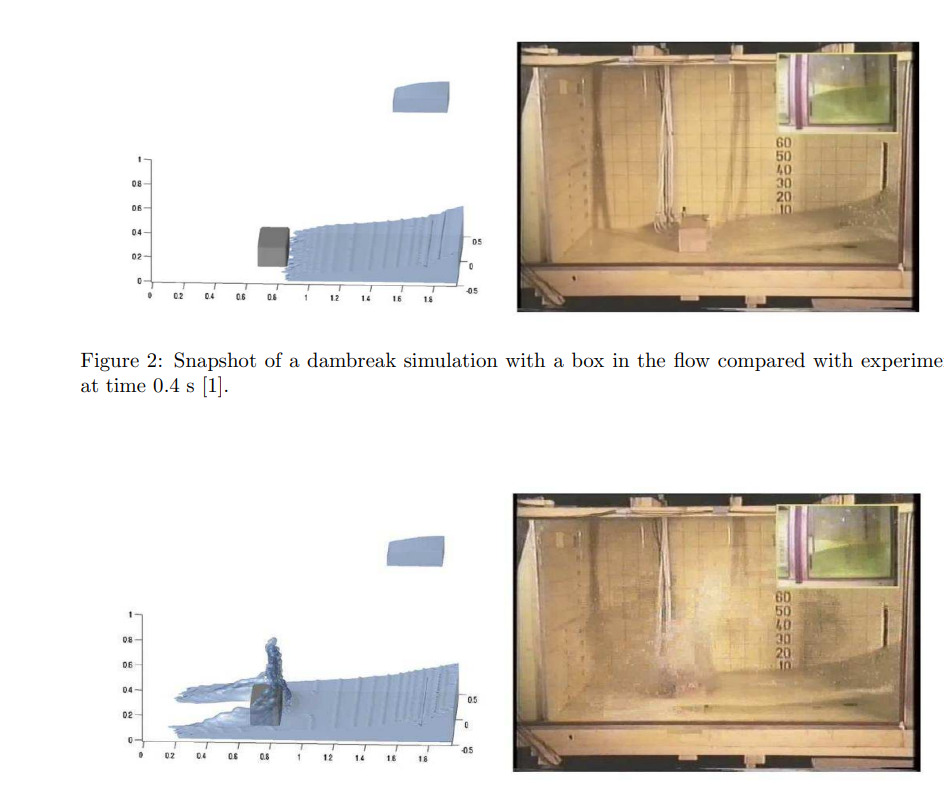
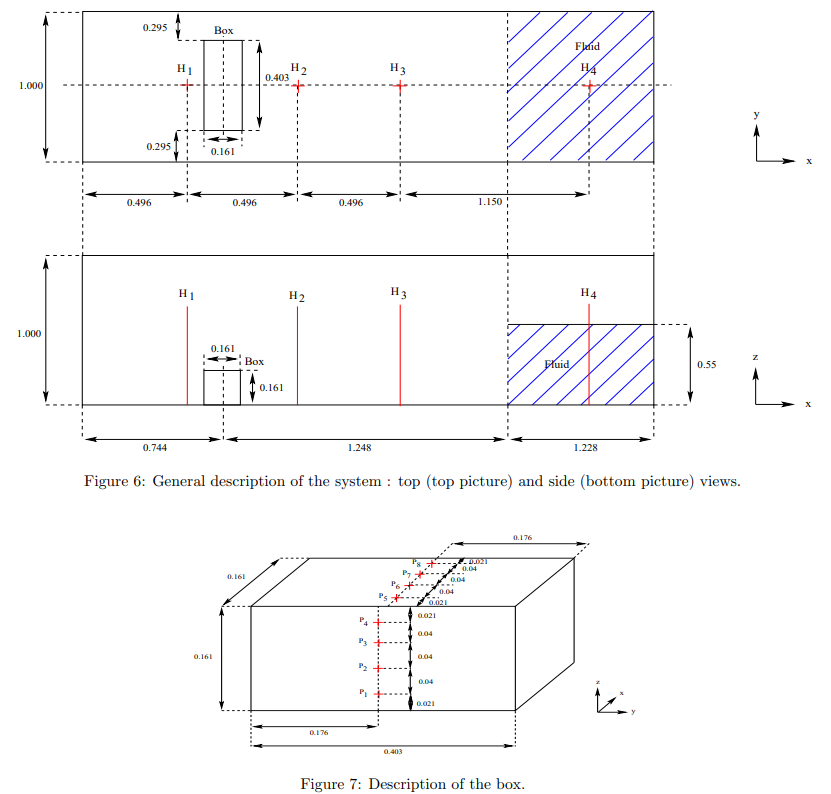
このような実験で得られた物理量とCAE解析で得られた結果の比較を行い、解析の妥当性の検証を行いたいと思います。
参考書
PENGUINさんサイトを体系的に学べる書籍となっています。ネット記事でも十分勉強できるのですが、OpenFOAMの初学者でOpenFOAMをインストール済みであれば一冊持って置き、体系的に学ぶのが良いでしょう。
あとは初心者向けに丁寧に解説がされているこちらの書籍もお勧めです。最後の章にはオーバーセットメッシュ(重合メッシュ)の機能を使った解析を最後まで丁寧に解説しているので挫折することはないでしょう。
